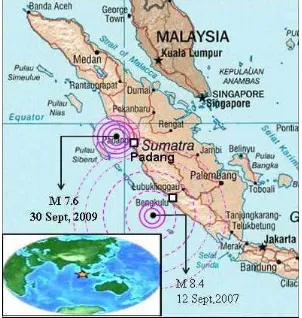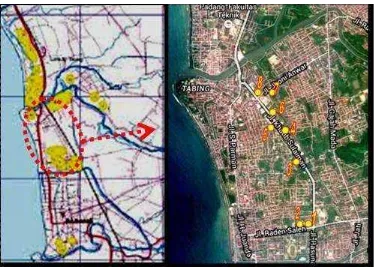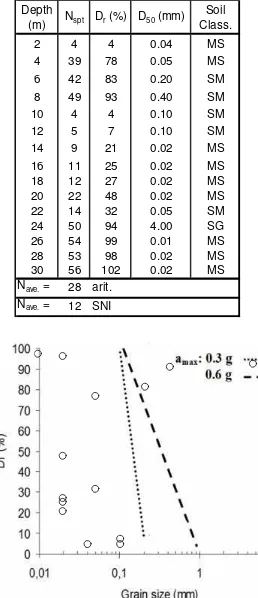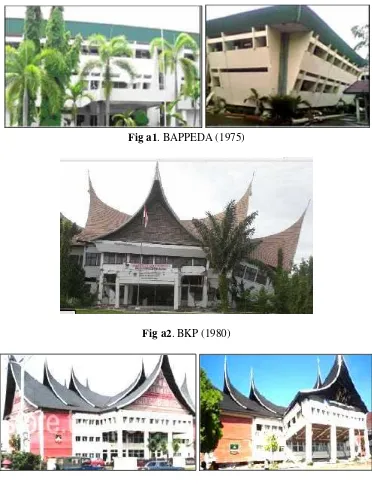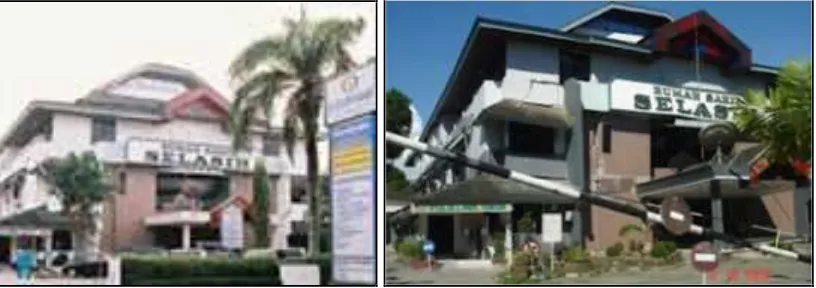Lesson Learnt from Padang Earthquake 2009:
The Liquefaction effects to Collapsed Buildings
Abdul Hakam1 and Bambang Istijono2
1 and 2
. Civil Dept. of University of Andalas, Padang, Indonesia email: [email protected], [email protected]
Abstract
Liquefaction in a soil deposit is an important aspect of earthquake engineering practice since its contribution to the safety of construction. Padang 30 September 2009 earthquake had caused liquefaction at several locations and triggered to damage in a number of buildings on the site. The earthquake is located in 100 km offshore of Padang City, the Capital City of the province. Survey has been conducted to assess the damage of the important buildings in few days after the earthquake. Many soil investigations after the earthquake then were done on the site for liquefaction potential assessment as well as to study the advanced earthquake understanding. It is found that the location of building has profound influence on the performance of buildings. The depth of the soil layer that potentially to liquefy in Padang is generally in the depth of less than 20m. After the earthquake, to reduce risk on constructions, the earthquake resistant code was revised which give the seismic load more the twice. The investigation on building site should be based on local geology and the subsoil properties which related to the earthquake ground motion. Seismic micro zoning and liquefaction potential maps in this seismic area will be helpful in the future design of building.
Keywords: Lessons learnt; liquefaction; earthquake; risk reduction;
1. Introduction
Padang is the capital city of West Sumatra province, Indonesia, located on the west-side of the Sumatra island. Topographically Padang city is relatively flat in general with hills on the east side. There are five main rivers start flowing from the east-hills go trough Padang to the west-coast. These rivers geologically create the history of the soil formations in the Padang city. This geological phenomena make the soil in the Padang city of sedimentary rocks in the size of a boulder, sand to clay particle.
Padang city also known as the one of earthquake prone cities in the world. This is due to the intersection of the Eurasian and Australian plates beneath the west side of Sumatra island. The big earthquakes in Padang began to be recorded in the year of 1779 and 1838. Both the earthquakes had made disaster and also led to the tsunami in the Padang city. Those earthquakes occurred as a result of shifting plates in the subduction area in the west side of Padang. At the moment it is expected a very big earthquake will happen again (the giant earthquake) with the focus in the West Sumatran megathrust.
The recent big earthquakes happened in Padang in 2007 and 2009(BMKG/USGS, 2009). The 2007 earthquake in the south direction of the Padang has damaged the city and also created a tsunami to a height inundation up to 1 m on the mainland. In addition, during this earthquake also made soil liquefaction in some areas. The damage caused by the liquefaction are indicated by some of the following events :
The subsidence of ground surface in some locations significantly.
The occurrence of loss of lateral bearing capacity of soil to lead the lateral spreading.
Increase the lateral earth pressure to cause the failure of the of the retaining structures, such as at raise bridges.
The liquefaction phenomenon in 2009 was also observed in several locations in Padang. Similar occurrences to previous earthquakes also happened in the city of Padang .
Fig 1. Recent big earthquakes in 2007 and 2009 in West Sumatra
Indonesian earthquake load regulation for buildings firstly was made in 1987, that is named SNI 03-1726-1987. Before that regulation, there is still introduced earthquake loads as temporary external load in code of N.I.-18, 1970. In 2002, the earthquake resistant building code of SNI 03-1726 is revised. The earthquake load is generally increased but still with the same procedure as before. Padang earthquake is then triggering to do the major revision of the earthquake in Indonesia. Based on historical collection of seismic events and the latest research on the geology of the area Indonesia, the earthquake regulations then was issued in 2012, named SNI 03-1726-2012. The 2012 Code of gives earthquake load by nearly doubled in certain compared to the previous earthquake loads.
2. Damaged buildings due to Padang earthquake
POLTEKES and LIA. While the PU PENGAIRAN building that have been severely damaged by the earthquake in 2007 was grounded by the 2009's earthquake. The locations of those buildings were reported to have the sign of liquefaction phenomena due to earthquake in 2009 ( Fig. 2 ).
Fig 2. Liquefaction in 2009 and locations of buildings. (Building name: 1. BAPPEDA, 2. BKP, 3. SAMSAT, 4. RS SELASIH, 5. SUTAN KASIM,
6. PU PENGAIRAN, 7. POLTEKES and 8. LIA)
BAPPEDA Building that was made in 1975s, can be classified as a very old construction. The building was built without any earthquake resistant building regulations in Indonesia. When the 2007 earthquake happened, the building is reported to suffered from liquefaction and there are cracks in the basement which indicated by boiled sand and leakages. The foundation of the building is made of shallow rounded caissons. This shape of the building also did not give an idea about an earthquake-safe building. This building has a greater mass on the upper level compared to the lower level. In addition the first level do not have wings to withstand shear forces such as the above levels. The first level is the most weak structure of the building. The building is collapsed due to the first level failed withstand earthquake shocks (soft first storey building ).
BKP building located adjacent with BAPPEDA building. This building consists of two floors only. The area of the second floor area wider than the ground floor so that the mass of the upper floor is greater than the lower one. This building also collapsed due to the first floor columns can not withstand during the earthquake. Similarly, the SAMSAT building that consists of only three floors but has a relatively wider on the second and third level. The SAMSAT building also showed the soft first storey building phenomenon. Even thought the structural configuration of those building is relatively simple but on the upper levels there is a mezzanine. This configuration shift up the stiffness and mass center of the building to the upper level.
nearly all around the building. This building is structurally also was not safe for occupation and should be demolished. The other adjacent building that was also eliminated is the two floor PU PENGAIRAN Office building. This building promptly has been severely damaged by an Bengkulu earthquake in 2007 and was not used anymore. During the earthquake in 2009 the building was total collapsed.
SUTAN KASIM building consists of six floors. It was made in the earlier of year 2007. This private owned building was relatively new and has not been used when the earthquake occurred. The building is badly damaged on the walls and slightly on structural elements. The building part that was suffered from severe damage is the between the second floor and the upper floors. The area lower floor is almost twice the upper one. This differences in geometry creates the sudden stiffness change between the second and the third floors.
In addition there are other buildings the same area were also severely damaged by the 2009 earthquake, that are POLTEKES and LIA buildings which privately owned and used for educational facilities . The buildings are relatively new but because they were private properties, they unlikely would refer to the building codes.
Indonesian building regulation used when those damaged buildings were built was SNI-1987. That Code was not considering the ground liquefaction at the time. The later regulation in 2002 are also not yet pay attention to the liquefaction. Then, those buildings were not considering the occurrence of liquefaction and seismic effects due to liquefaction. Those earlier Codes only classified the soil layer (site) into hard, medium and soft sites, based on the average value of standard penetration resistance .
The new SNI regulations 2012 has classified the sites including the liquefaction potential soil layer in a specific class. The ground with collapsible and potentially fail due to seismic (including easily to liquefy), very sensitive clays, weak cemented soils and thick peat sediments, are classified as a specific site (SF site). A location belonging to the SF site requires specific geotechnical investigation and response analysis as well.
3. liquefaction studies
Following the 2009 earthquake, a number of seismic and liquefaction studies have been conducted in the Padang city. Geotechnical explorations were done by core drilling at the sites, as well as the test of sampling in the field and laboratory. A particular data of geotechnical drilling as well as field and laboratory tests from BAPPEDA Building location is shown in Table 1. Based on the average standard penetration resistance in the old regulations, the BAPPEDA location were classified to a soft soil site.
The groundwater table in the site is at a depth of 2 meters. The type of soil layers are dominated by the sediment layer of sandy or silty soils. Based on data from the grain size and relative density, it can be analyzed that the location has liquefaction potential layers (Figure 3).
Table 1. Soil data for Padang liquefied area.
4. Lessons Learnt
Based on the liquefaction studies in Padang, it is concluded that the Padang city area is prone to liquefaction. Then, it is necessary to put liquefaction consideration in the development in of the Padang city. The old version of earthquake safe building regulations only categorize soil in the building location based on the soil hardness but not soil behavior yet. Beside the seismic load, the liquefaction behavior of soils also depends on other parameters such of soil particle size, density and history of the occurrence.
An amplification of earthquake loads may occur during the liquefaction. The behavior amplification during liquefaction should be analyzed further. Then construction design on a specific areas with liquefaction potential soil layers must involve special structural analysis to consider the effects of liquefaction. The areas where liquefaction are not expected to happen, can apply a general structural analysis for construction designs.
The loss of bearing capacity is the most important effect of liquefaction. The effect of liquefaction to the bearing capacity has been reported as well by Lo and Wang (2012). Further, the differential settlement due to the effect of liquefaction should be considered as well in the analysis of the structures. Internal forces that involved in the structural reinforcement of the building must also take into the additional forces due to differential foundation of the building. Numerical simulations involving soil-structure interaction can be an option as an analysis tool to solve the problem.
The liquefaction potential map becomes essential to get a good picture of liquefaction hazard in a specific area. In order to obtain a right earthquake loads for a given site, the mokrozonasi study that involves local conditions is needed (Sengara et al, 2011). Furthermore, to facilitate the application in earthquake-safe design, the seismic zoning map based on the response analysis of the each location also can be done.
5. Conclusions
The severely damages to the buildings during the Padang earthquake in 2009 happened in the areas that have the liquefaction potential. Based on the survey on the number of buildings in the areas, then the effect of liquefaction in non-uniform settlement of buildings also contributed to the destruction of the building. The amplification effect of earthquake loads on the building during the liquefaction should be studied further. Lessons learned can be drawn from this event to steps forward in future anticipation, as follows:
Seismic micro-zoning is essential
Liquefaction potential is necessary to be mapped.
Seismic analysis should be specific to the area that potentially liquefaction.
Development of soil structure interaction analysis which involves the phenomenon of liquefaction therein.
The earthquake load for design needs to consider not only the source of the earthquake but the local geotechnical conditions as well.
References
Anon., Indonesian Public Work Department. Indonesian Loading Guidelines, N.I.-18, 1970.
Anon., Indonesian Public Work Department, Earthquake Resistance Design Guidelines for Buildings, SNI 03-1726-1987, Jakarta, 1987.
Anon., Indonesian Earthquake Resistance Design Guidelines for Buildings, SNI 03-1726-2002, Jakarta, 2002.
Anon., Indonesian Earthquake Resistance Design Procedures for Buildings and Non-building. SNI 03– 1726 - 2002 , Jakarta, 2012
BMKG/USGS, September 30, 2009 Strong Ground Motion Record from Padang, http://www.bmg.go.id/depan.bmkg, 2009.
Hakam, A. and H Darjanto, Liquefaction Potential in Padang Beach Based on Soil Gradation and Standard Penetration Test (in Indonesian: Penelusuran Potensi Likuifaksi Pantai Padang Berdasarkan
Gradasi Butiran dan Tahanan Penetrasi Standar), Jurnal Teknik Sipil– ITB, 2012, 33-38
Lestari, A. S., P P Rahardjo, Metta Devi Hartadi and Antony Kesuma Report: The potential for liquefaction assessment based on the concept of critical state , and piezocone test on the cemented sand of the city of Padang (in Indonesian: Kajian Potensi Likuifaksi berdasarkan konsep critical state dan
uji piezocone pada semen pasiran kota Padang), LPPM, Univ. Parahyangan, 2014
Lo Robert C. and Yumei Wang (2012). Lessons Learned from Recent Earthquakes – Geoscience
and Geotechnical Perspectives, Advances in Geotechnical Earthquake Engineering - Soil Liquefaction and Seismic Safety of Dams and Monuments, Prof. Abbas Moustafa (Ed.), ISBN: 978-953-51-0025-6, InTech.
Sengara I.W., M. Irsyam, I.D. Sidi, M. Merati, K.S. Pribadi, S. Krishna, M. Suarjana, M. Edwards, Seismic Disaster Risk Reduction and Damage Mitigation for Advancing Earthquake Safety of Structures, The Second International Conference on Earthquake Engineering and Disaster Mitigation (ICEEDM-2) Surabaya, Indonesia, 2011.
Warman, H. and D Y Jumas, Study of liquefaction potential on post-earthquake for disaster mitigation in Padang (in Indonesia: Kajian potensi likuifaksi pasca gempa dalam rangka mitigasi bencana
annexes :
Damaged building figures due to Padang earthquake in 2009Fig a1. BAPPEDA (1975)
Fig a2. BKP (1980)
\
Fig a4. SUTAN KASIM (2007)
Fig a5. PU PENGAIRAN (1992)
